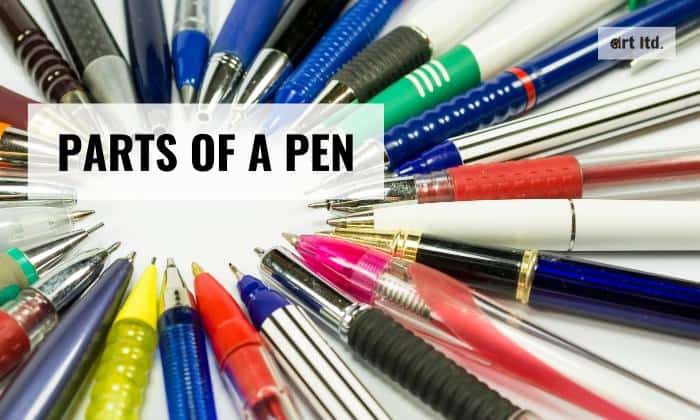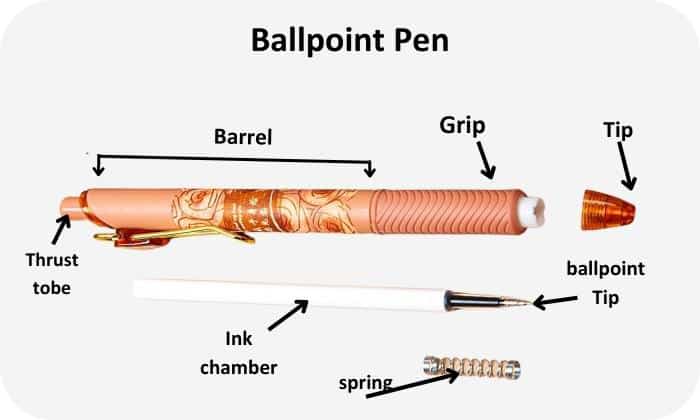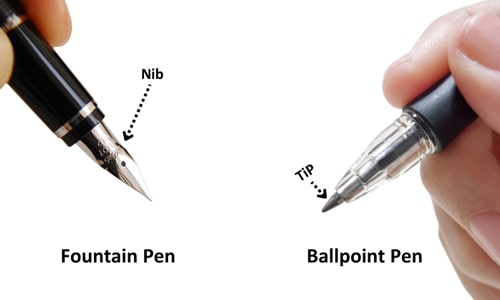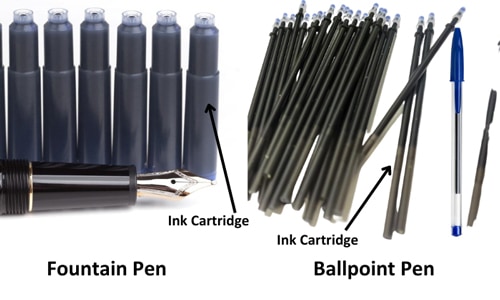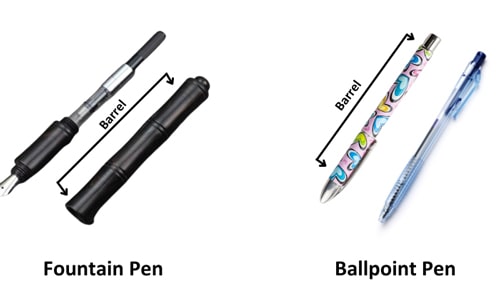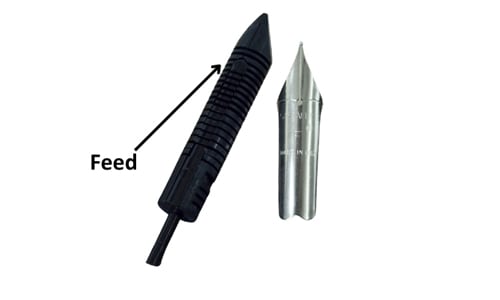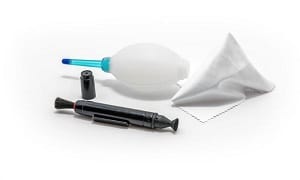Are you curious about the intricate inner workings and parts of a pen?
The components of a pen that constitute its very essence encompass the tip, ink cartridge, barrel, thrust device, converter, and feed, each crafted to serve a distinct purpose.
Let us unravel the secrets behind each part of a pen as we embark on an odyssey where we will go over the terrain of pen anatomy.
Table of Contents
Different Parts of a Pen
We will explore the details of each element outside and inside of a pen, shedding light on its role, significance, mechanism, and how the subsystems of a pen collaborate to deliver an exceptional writing experience. A diagram is also provided for better understanding and visual clarity.
1. Tip or Nib
Main Role
The tip is the point of contact between the pen and the writing surface, facilitating the deposition of ink onto the page. What is the tip of a pen called? It is also referred to as a nib.
Whatever the pen type is, the nib acts as the conduit through which ink flows.
Significance
It determines the thickness, consistency, and style of the lines produced during writing. By selecting the appropriate tip size, the writer can achieve the desired level of precision and expressiveness.
How It Works
The functioning of the pen tip varies depending on the pen type.
- Fountain Pen: The nib consists of a slit that draws ink from the cartridge through capillary action. This ink then flows onto the paper as the writer applies pressure and moves the pen across the surface.
- Ballpoint Pen: A ballpoint tip employs a small metal ball housed within the tip. As the ball rolls, it picks up ink from the cartridge and transfers it onto the paper.
Mechanics
The mechanics of the pen tip involve a delicate interplay between the nib and the ink cartridge.
- Fountain Pen: The nib’s shape, size, and flexibility influence the ink flow, line thickness, and general character of the writing.
- Ballpoint Pens: Ballpoint pen tips, with their small ball bearings, rely on precise engineering to ensure controlled ink delivery, preventing leakage and ensuring consistent line width.
2. Ink Cartridge
Main Role
The cartridge is the component that holds the ink until it is ready to be used for writing.
Significance
This component ensures that the pen remains functional by providing a steady supply of ink for writing. In some pens, the ink cartridge is either replaceable or refillable, thus extending the writing instrument’s lifespan.
Mechanics
The ink reservoir is typically a plastic tube that is pre-filled with ink and attached to the feed of the pen, which is responsible for delivering the ink to the pen’s tip.
3. Barrel
Main Role
The barrel of a pen serves as the main body that contains the internal components of the pen, especially the ink cartridge. It provides structural support and protection to the inkwell inside.
Significance
The barrel of pen plays a significant role in the overall functionality and user experience. It contributes to the pen’s weight, balance, and comfort during writing.
How It Works
The barrel works by providing a secure housing for the ink cartridge, ensuring its stability and preventing leakage and ink evaporation.
Mechanics
The choice of materials for the barrel is crucial as it affects factors such as weight, hardness, strength, and reactivity.
Lightweight materials are often preferred, especially for pens intended for long periods of use, as they reduce hand fatigue. Hardness ensures the barrel’s protective function, guarding the inkwell against external impact.
4. Thrust Device (For Retractable or Click Pens)
Main Role
The thrust device and spring in a retractable pen are responsible for pushing or retracting the pen tip in and out of the barrel. What they do is enable the iconic clicking mechanism that allows the pen to transition between writing and non-writing positions.
Significance
The thrust device or cam is the key component responsible for the clicking action of a click pen. The grooves, slants, and ledges interact with the ink cartridge, determining its position each time you click the pen.
The spring provides the necessary force to move the cartridge and maintain it in either the extended or retracted state.
How It Works
The clicking mechanism parts of a retractable pen involve a series of distinct actions. With each click, the thrust device interacts with the spring to position the ink cartridge accordingly.
The cam rotates or moves to specific grooves, allowing the spring to extend or retract the cartridge. The precise design of the thrust device determines the pen’s various positions, ensuring it is ready for writing or securely retracted.
Mechanics
When you press down on the pen’s button, it compresses a spring located inside its barrel. Your finger’s force is enough to overcome the spring’s resistance, causing the spring to release and extending the pen’s tip.
5. Feed (For Fountain Pens)
Main Role
The feed is one of the major fountain pen parts. It is the component located under the nib of the fountain pen. Its primary function is to control the ink’s flow from the reservoir to the nib.
Significance
The feed ensures a continuous and controlled flow of ink to the nib, allowing for smooth and consistent writing. It also helps regulate the ink flow and can impact the wetness or dryness of the fountain pen’s performance.
How It Works
The feed sits flush against the underside of the fountain pen nib and contains channels that are connected to the reservoir. These channels draw ink from the reservoir, and the nib’s slit then carries the ink to the fountain pen nib’s tip, enabling writing.
Mechanics
There are two common types of feed: plastic and ebonite (hard rubber).
- Plastic Feed. Common in modern pens due to their cheap price, plastic feeds are intricately designed to deliver better ink and air flow.
- Ebonite (Hard Rubber) Feed. Ebonite feeds offer better capillary action, allowing for a wetter ink flow. They can be heat-set to improve flexibility and conform to adjacent parts of the pen.
6. Converter (For Fountain Pens)
Main Role
A fountain pen converter is a small device that allows you to fill a fountain pen with bottled ink instead of using disposable ink cartridges.
Significance
The converter gives fountain pen users the freedom to choose from a wide range of ink colors and brands, as opposed to being limited to proprietary ink cartridges. It allows for personal expression and experimentation with different inks to suit individual styles.
How It Works
Two notable varieties of fountain pen converters are available: piston and squeeze converters.
- Piston converters: The mechanism may vary between screwing (twisting motion) or plunger (pushing downward) to draw ink into the pen. This is the most common type of converter.
- Squeeze converters: It has a similar concept to an eyedropper where the air is squeezed out, extracting ink and delivering it into the pen.
Mechanics
Fountain pen converters utilize simple mechanisms to create a vacuum that draws ink from the bottle into the pen’s reservoir. The specific mechanism depends on the type of converter being used.
The converter serves as a convenient alternative to ink cartridges, providing a refillable solution for fountain pen enthusiasts.
Frequently Asked Questions
How Do I Clean The Different Parts Of A Pen?
Cleaning the Tips:
- Use a soft cloth or tissue to gently wipe the tip of the pen.
- If there is dried ink, you can soak the tip in warm water or vinegar for a few minutes to loosen the ink. For alcohol-based ink, dip the pen in rubbing alcohol instead.
- Use a bulb syringe or a flush syringe to flush water through the tip and clear any remaining ink.
- Repeat the process until the water runs clear.
- Gently dry the tip with a soft cloth or tissue.
Cleaning the Barrel:
- Disassemble the pen by unscrewing the barrel from the grip section.
- Rinse the barrel with warm water to remove any ink residue.
- If necessary, use a mild soap solution to clean the barrel, then rinse thoroughly afterward.
- Dry the barrel completely before reassembling the pen.
Cleaning the Converter (For Fountain Pens):
- Unscrew the grip section of the pen from the barrel.
- Remove the ink cartridge or detach the ink converter while keeping it upright to avoid spills.
- Soak the nib if needed to soften dried ink.
- Flush the nib and feed with water using a bulb syringe until the water runs clear.
- Dry the pen and converter with a microfiber cloth, then reassemble the pen and fill it with ink.
Please note that specific cleaning instructions may vary depending on the type and brand of pen. It’s always recommended to refer to the manufacturer’s guidelines for the best cleaning practices.
Can I Replace Or Upgrade Specific Pen Parts?
Yes, it is often possible to replace or upgrade specific parts of a pen. The availability of replacement parts and the ease of replacement can vary depending on the pen model and brand.
Some common parts that can be replaced or upgraded include nibs, feeds, converters, and cartridges.
What Should I Consider When Purchasing A Pen Based On Its Parts?
- Choose a pen made from durable parts that feel comfortable in your hand. Common options include metal, plastic, or rubber.
- Writing Comfort. Look for a pen with a soft grip and lightweight design to ensure comfortable writing. The pen should also feel balanced in your hand.
- Select a pen size that fits your preference. Pens with thinner barrels may be suitable for beginners or those with smaller hands, while pens with thicker barrels offer a different writing experience.
- Find a balance between affordability and quality. Quality pens have superior parts, and they tend to provide better reliability.
Conclusion
There you have it! Now you’re well-versed in all parts names and their important roles.
By understanding how the tip, ink cartridge, barrel, thrust device, converter, and feed work together harmoniously, you can appreciate the artistry and engineering behind every pen.
The next time you write, take a moment to admire the synergy between the parts of a pen and let the magic unfold as you create stories, memories, and meaningful connections through the power of writing.

Art has always been a part of my life; it influences my upbringing and later my career choice. For me, it is always a part of my parenting technique. So for whichever purpose that you come to art, you can start here with us.
